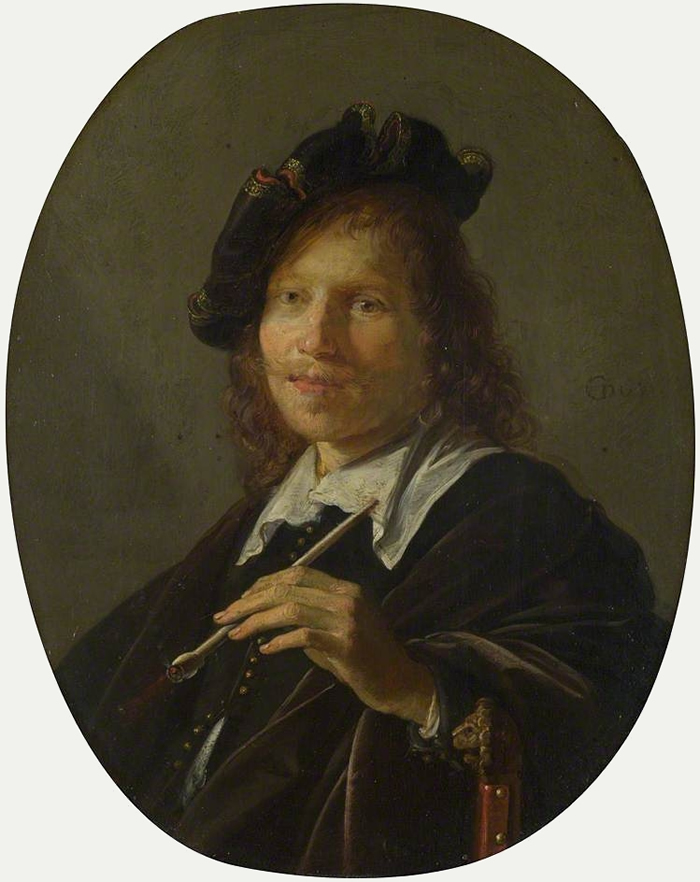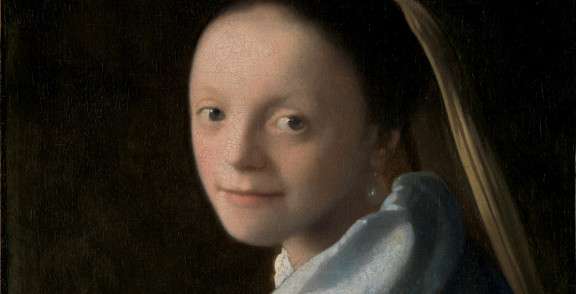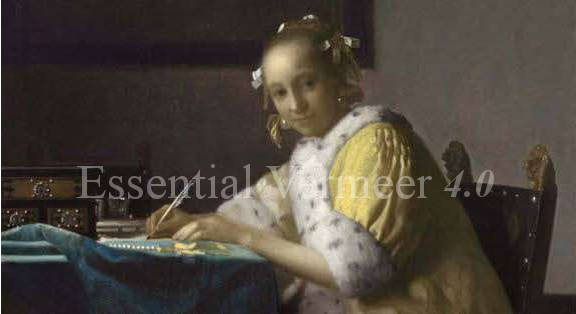Portrait of a Man
Gerrit Douc. 1635–1640
Oil on oak, 18.9 x 14.7 cm.
The National Gallery, London

Gerrit (Gerard) DOU
Leiden 1613-Leiden 1675
Dou occupies a central position in the art of his own time to a point where it is difficult to over-estimate his importance. His early training was with Rembrandt before the latter left Leiden c. 1631/2. They collaborated on at least one picture, the Anna and the Blind Tobit which is in the National Gallery, London. Dou spent the whole of the rest of his career in his native Leiden and he clearly rejected whatever he may have learned from Rembrandt, instead he concentrated on small, highly finished pictures of wide-ranging subject manner, of which he was one of the most proficient masters who has ever lived.
His pictures are curiously restrained in their colour scheme; they have to be appreciated by close inspection. Whatever Dou may have known about Rembrandt, Hals and Vermeer, for him their art did not exist. Instead he became an enormously important teacher whose influence was to last almost 200 years. He taught Gabriel Metsu and Godfried Schalcken, encouraging them towards painting the highly finished pictures which dominated Dutch taste in the eighteenth and early nineteenth centuries.
Obviously Dou has been removed from the pedestal on which the taste of the eighteenth and nineteenth centuries placed him. Minute detail is no longer considered a sound basis on which to assess the merit of a painting. The twentieth century has lost respect for this skill, and Dou's controlling position in Leiden is too easily forgotten by modern historians seeking to justify their preference for less influential painters. It has often been suggested, not unreasonably, that Dou's Lady at the Virginals (in the Dulwich Gallery) is the source of inspiration for Vermeer's Lady Seated at a Virginal (in the National Gallery, London), which was probably painted some ten years later than Dou's work.
Dou covered a wide range of subject matter, from religious work to most of the different aspects of genre painting. One of his most elaborate and significant pictures is the Quack of 1652 (Rotterdam, Boijmans-van Beuningen Museum), which shows a group of people being taken in by the nonsense of the smooth-talking charlatan. The picture is as full of incident as one by Jan Steen, even down to such normally unmentionable daily events as a mother wiping clean her child's bottom. Dou himself leers into the picture as a spectator through the window.
Dou's religious pictures have the same meticulous technique and small scale; a typical example is the Hermit (Amsterdam, Rijksmuseum), where there is almost a sense of humour in the old man's facial expression.
It was Dou's technique which was to form the basis far the Leiden school of fijnschilders or fine painters. His influence was strongest on the van Mieris dynasty, who often painted more elaborate and highly coloured compositions than did Dou himself. But they always remained faithful to the perfectly polished surface in which every detail was included with the utmost respect.
from:
Christopher Wright, The Dutch Painters: 100 Seventeenth Century Masters, London, 1978
- Willem van Aelst (2)
- Balthasar van der Ast (6)
- Hendrick Avercamp (3)
- Dirck van Baburen (7)
- Jacob Adriaenz. Backer (3)
- David Bailly
- Ludolf Bakhuysen
- Bartholomeus van Bassen
- Cornelis Bega
- Gerrit Berckheyde (2)
- Gillis Gillisz de Bergh
- Jan van Bijlert (7)
- Jan de Bisschop (2)
- Abraham Bloemaert (4)
- Pieter De Bloot
- Ferdinand Bol (3)
- Hans Bollinger
- Paulus Bor (2)
- Ambrosio Bosschaert (7)
- Jan Both
- Leonaert Bramer (4)
- Salomon de Bray (2)
- Quiringh van Brekelenkam (4)
- Jan Gerritszoon van Bronchorst (2)
- Adriaen Brouwer (5)
- Hendrick ter Brugghen (6)
- Hendrick van der Burch (5)
- Willem Buytewech (6)
- Abraham van Calraet (2)
- Jacob van Campen
- Jan van de Cappelle(3)
- Pieter Claesz (4)
- Pieter Codde (6)
- Adriaen Coorte (9)
- Josse van Craesbeeck (2)
- Aelbert Cuyp (6)
- Philip van Dijk
- Gerrit Dou (10)
- Willem Drost (2)
- Hendrick Dubbels
- Jacob Duck (4)
- Karel Dujardin (3)
- Willem Duyster (5)
- Gerbrand van den Eeckhout
- Pieter Jansens Elinga
- Cesar van Everdingen (5)
- Allaert van Everdingen
- Carel Fabritius (5)
- Goveart Flinck
- Frans Francken the Younger
- Aert de Gelder
- Cornelis Gijsbrechts
- Jan van Goyen (6)
- Frans Hals (3)
- Dirck Hals (5)
- Jan Davidsz. Heem (6)
- Maerten van Heemskerck
- Bartholomeus van der Helst (4)
- Jan van der Heyden (8)
- Meyndert Hobbema (3)
- Gerard van Honthorst (8)
- Pieter de Hooch (12)
- Van Hoogstraten (9)
- Gerard Houckgeest (4)
- Jan van Huysum (3)
- Willem Kalf (4)
- Jan van Kessel
- Philip Koninck (2)
- Gérard de Lairesse (5)
- Pieter Lastman
- Judith Jansdochter Leyster (5)
- Jan Lievens (4)
- Jacob van Loo (7)
- Nicolaes Maes (9)
- Cornelis de Man (5)
- Gabriel Metsu (12)
- Michiel Janz. van Mierevelt (3)
- Frans van Mieris (8)
- Jan Miense Molenaer (5)
- Pieter Molijn (2)
- Paulus Moreelse (2)
- Pieter Mulier
- Michiel van Musscher (5)
- Aert van der Neer (3)
- Eglon van der Neer (3)
- Caspar Netscher (5)
- Jacob Ochervelt (8)
- Jacob van Oost (2)
- Adriaen van Ostade (5)
- Antonie Palamedesz (6)
- Adam Pijnacker (5)
- Egbert van der Poel (2)
- Jan Porcellis (4)
- Pieter Symonz. Potter
- Paulus Potter (7)
- Pieter Jansz. Quast (2)
- Rembrandt van Rijn (complete oeuvre)
- Jacob van Ruisdael (8)
- Solomon van Ruisdael (7)
- Rachel Ruysch (2)
- Pieter Saenredam (3)
- Godfried Schalcken (6)
- Hercules Segers (2)
- Hendrick Sorg (4)
- Jan Steen (8)
- Harmen Steenwyck (3)
- Matthias Stom (2)
- Michael Sweerts (6)
- David Teniers the Younger
- Gerrit ter Borch (15)
- Willem van de Velde (7)
- Jacob van Velsen
- Johannes Verkolje (2)
- Jan Cornelisz Verspronck (4)
- Abraham de Verwer
- Simon de Vlieger
- Hendrick van Vliet (2)
- Daniel Vosmaer (4)
- Jacobus Vrel (8)
- Jacob van Walscapelle (2)
- Jan Baptist Weenix (2)
- Jan Wijnants (3)
- Emanuel de Witte (6)
- Philips Wouwermans (2)




 or anything else that isn't working as it should be, I'd love to hear it! Please write me at:
or anything else that isn't working as it should be, I'd love to hear it! Please write me at: